Francesco Bartolomeo Rastrelli
Francesco Bartolomeo Rastrelli (Russian: Франче́ско Бартоломе́о (Варфоломе́й Варфоломе́евич) Растре́лли; 1700 in Paris, Kingdom of France – 29 April 1771 in Saint Petersburg, Russian Empire) was an Italian architect who worked mainly in Russia. He developed an easily recognizable style of Late Baroque, both sumptuous and majestic. His major works, including the Winter Palace in Saint Petersburg and the Catherine Palace in Tsarskoye Selo, are famed for extravagant luxury and opulence of decoration.[1]
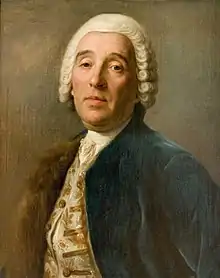
Biography
In 1716, Bartolomeo moved to Saint Petersburg, which became a new Russian capital just a four years before, accompanying his father, Italian sculptor Carlo Bartolomeo Rastrelli (1675–1744).[1] His ambition was to combine the latest Italian architectural fashion with traditions of the Muscovite Baroque style. The first important commission came in 1721 when he was asked to build a palace for Prince Demetre Cantemir, former ruler of Moldavia.
He was appointed to the post of senior court architect in 1730. His works found favour with female monarchs of his time, and he retained this post throughout the reigns of Empresses Anna (1730–1740) and Elizabeth (1741–1762).
Rastrelli's last and most ambitious project was the Smolny Convent in St. Petersburg where Empress Elizabeth was to spend the rest of her life. The projected bell-tower was to become the tallest building in St Petersburg and all of Russia. Elizabeth's death in 1762 prevented Rastrelli from completing this grand design.[1]
The new empress, Catherine II, dismissed Baroque architecture as an old-fashioned "whipped cream", and the aged architect retired to Courland, where he supervised the completion and decoration of the ducal palaces.
His last years were spent in obscure commerce with Italian art-dealers. He was elected to the Imperial Academy of Arts several months before his death.[1] A square in front of the Smolny Convent has borne Rastrelli's name since 1923. He is the subject of a composition, Rastrelli in Saint Petersburg, written in 2000 by Italian composer Lorenzo Ferrero.
Ten extant buildings by Rastrelli
| # | Image | Name | Location | Date |
|---|---|---|---|---|
| 1 | .jpg.webp) |
Rundāle Palace | Pilsrundāle near Bauska |
1736–1740 1764–1767 |
| 2 | 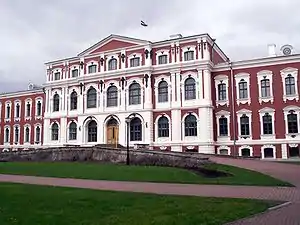 |
Jelgava Palace | Jelgava |
1738–1740 1763–1772 |
| 3 |  |
Peterhof Palace | Peterhof near St. Petersburg |
1747–1755 |
| — | 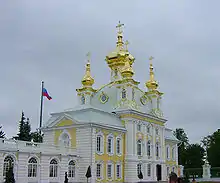 |
Peterhof Palace chapels | Peterhof near St. Petersburg |
1747–1751 |
| 4 | 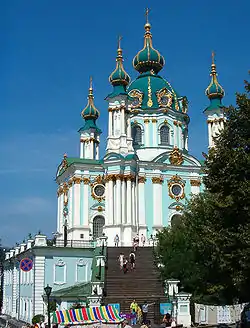 |
Saint Andrew's Church | Kyiv |
1748–1767 |
| 5 | 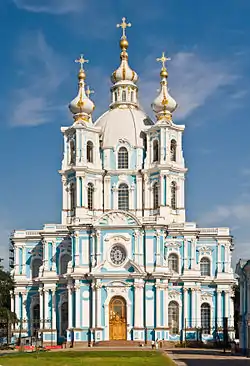 |
Smolny Convent | St. Petersburg |
1748–1764 |
| 6 |  |
Vorontsov Palace | St. Petersburg |
1749–1757 |
| 7 |  |
Catherine Palace | Tsarskoe Selo (Pushkin) |
1752–1756 |
| — | 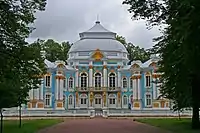 |
Hermitage Pavilion | Tsarskoe Selo (Pushkin) |
1749 |
| 8 | 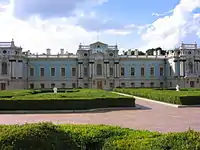 |
Mariyinsky Palace | Kyiv |
1752 1870 |
| 9 | .jpg.webp) |
Stroganov Palace | St. Petersburg |
1753–1754 |
| 10 | 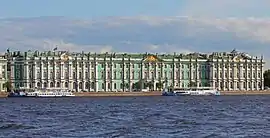 |
Winter Palace | St. Petersburg |
1754–1762[2] |
Boris Vipper has speculated that Rastrelli's last (and unfinished) design was for the Neoclassical Zaļenieki Manor near Mitava.
Demolished buildings
| # | Image | Name | Notes | Location | Date |
|---|---|---|---|---|---|
| 1 |  |
Annenhof | Built of wood, replaced by Catherine Palace (Moscow) | Lefortovo District, Moscow |
1731 displaced 1736 burnt down 1746 |
| 2 |  |
Anna's Winter Palace | Replaced by Winter Palace | Saint Petersburg |
1732–1735 demolished 1754 |
| 3 |  |
Summer Palace | Built of wood, replaced by Saint Michael's Castle | Saint Petersburg |
1741–1744 demolished 1797 |
| 4 |  |
Winter Kremlin Palace | Replaced by Grand Kremlin Palace | Moscow Kremlin |
1747–1756 rebuilt 1798 demolished 1837 |
References
- Bartolomeo Francesco Rastrelli. Encyclopædia Britannica
- Ring, Trudy; Watson, Noelle; Schellinger, Paul (28 October 2013). Northern Europe: International Dictionary of Historic Places. ISBN 9781136639449.
External links
 Media related to Francesco Bartolomeo Rastrelli at Wikimedia Commons
Media related to Francesco Bartolomeo Rastrelli at Wikimedia Commons
